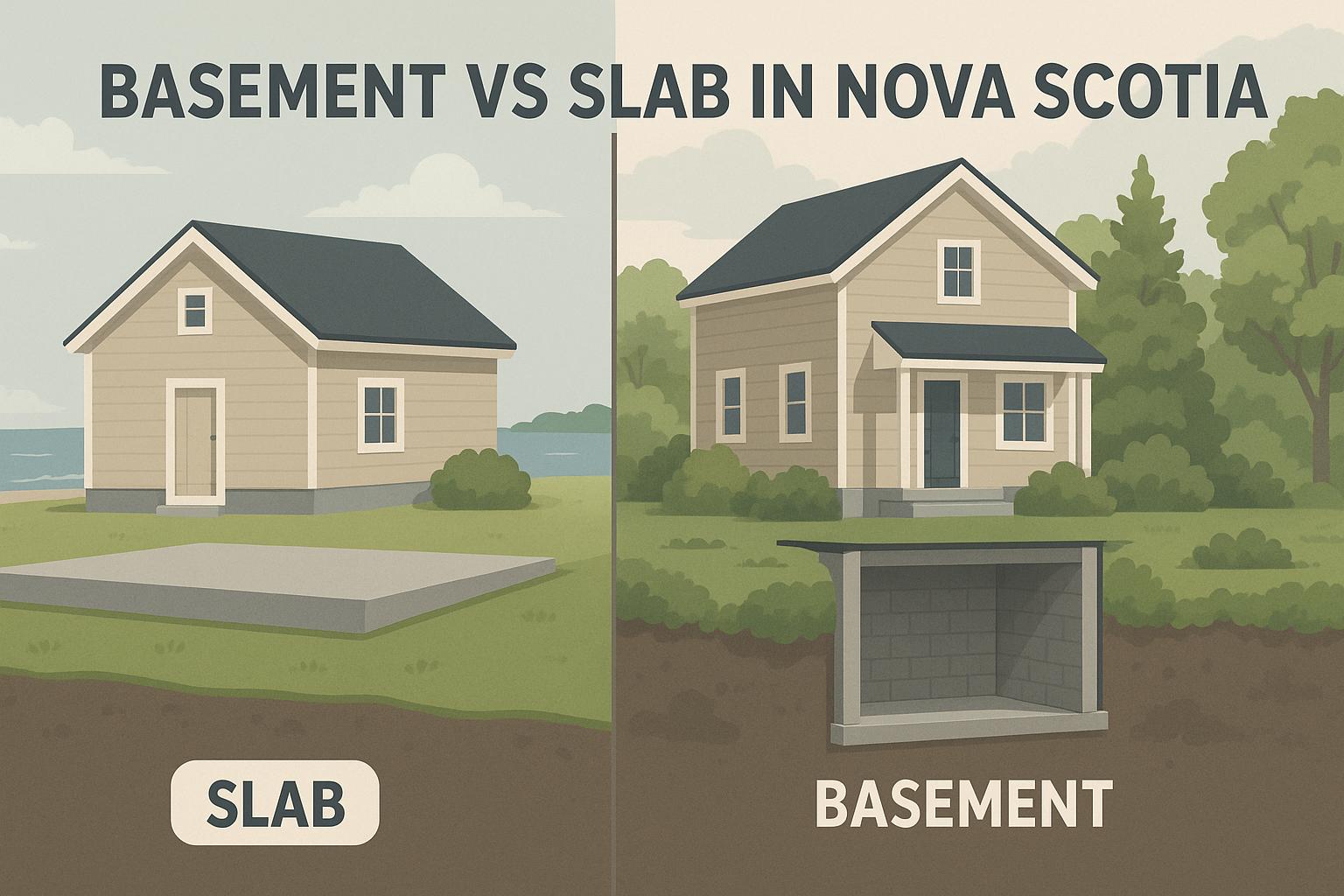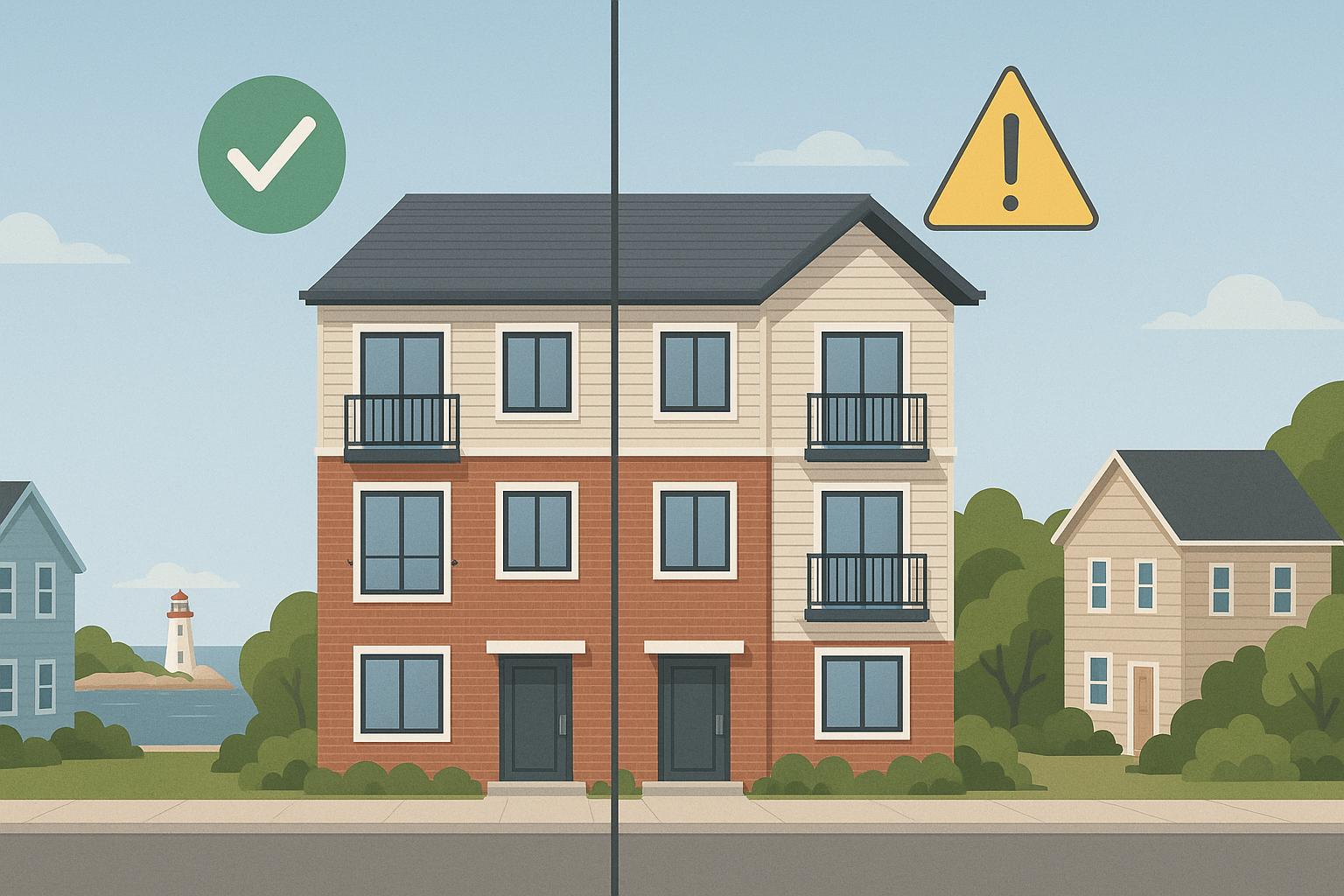Want to turn your land into multiple lots in Nova Scotia? Here's a step-by-step guide to help you navigate the subdivision process, whether you're splitting a single lot or planning a new community.
Key Steps:
- Check Feasibility: Confirm zoning rules, lot size requirements, and access to services like water and sewer.
- Create a Subdivision Plan: Hire a licensed Nova Scotia Land Surveyor for detailed plans and engineering designs if needed.
- Submit Your Application: Provide required documents, including survey plans, engineering reports, and fees, to your local Planning Department.
- Approval Process: Applications are reviewed by municipal departments, committees, and councils where necessary.
- Final Registration: After approval, register your subdivision plan with the Land Registration Office.
Timelines:
- Simple Split: 4–6 weeks
- Minor Subdivision: 8–12 weeks
- Major Subdivision: 16–24 weeks
Early consultations with planning staff and professionals can save time and money. Follow these steps to turn your land into approved lots while meeting all municipal and provincial requirements.
How to Subdivide Land? | 13 Considerations When Subdividing a Property
Nova Scotia Subdivision Laws
In Nova Scotia, land subdivision is governed by provincial laws and municipal bylaws to ensure development is both safe and well-organized. Here's a breakdown of the key terms and regional rules that influence the subdivision process in the province.
Basic Subdivision Terms
According to Nova Scotia's Municipal Government Act, a subdivision happens whenever one or more new parcels are created from an existing piece of land. This includes:
- Dividing a single property into multiple lots
- Transforming farmland into lots for building
- Adjusting property boundaries
- Merging several lots into one
In short, any change to property boundaries falls under this definition.
Government Rules by Region
While the province sets general guidelines, municipalities add their own rules through land-use bylaws. For instance, municipal governments, such as the West Hants Regional Municipality (WHRM), handle local subdivision applications via their Planning Departments.
Municipal councils have significant authority over land development, influencing:
- Zoning regulations
- Minimum lot sizes
- Road frontage requirements
- Permitted uses for land
These rules vary between municipalities, depending on local priorities and development conditions.
Required Government Approvals
Getting a subdivision approved involves several government bodies, each playing a specific role:
| Authority | Role in Subdivision Process |
|---|---|
| Municipal Planning Department | Acts as the main point of contact and coordinates approvals |
| Planning & Heritage Advisory Committee | Reviews applications and provides recommendations |
| Municipal Council | Handles rezoning and bylaw amendments |
| Nova Scotia Regulatory and Appeals Board | Deals with appeals |
The process often requires input from multiple departments. For example, the WHRM Council recently considered amendments to the Windsor Land Use By-law for PID 45405784 on College Road [2].
For specific requirements in your area, reach out to your local Planning Department.
Step 1: Check if You Can Subdivide
Before diving into your subdivision project, it’s crucial to confirm that your property meets all local regulations. Here’s what you need to do.
Review Local Zoning Rules
Start by understanding your property’s zoning requirements. Key factors to review include:
- Minimum lot sizes
- Required road frontage
- Building setback rules
- Land use restrictions
For detailed zoning information, reach out to the West Hants Regional Municipality Planning and Development Department at 902-798-8391 ext. 115 or email planning@westhants.ca.
Check Land Limitations
Your property's physical features play a big role in determining its subdivision potential. Here's what to consider:
| Limitation Type | What to Examine |
|---|---|
| Environmental | Wetlands, floodplains, and protected areas |
| Services | Water supply and septic system requirements |
| Topography | Slope grades and drainage patterns |
| Access | Road frontage and driveway possibilities |
If municipal services like water and sewage aren’t available, each new lot must support its own well and septic system. Be prepared to provide proof that these services are feasible before moving forward.
Meet with Planning Staff
Set up a pre-application meeting with municipal planning staff to go over your project. The West Hants Planning and Development Department can help you:
- Review your subdivision concept
- Identify potential challenges
- Understand specific requirements
- Learn about the application process
To make the most of your meeting, come prepared with:
- Property documents
- A basic subdivision layout
- A list of questions
- Notes on any requirements you want clarified
These consultations are held at 76 Morison Drive, Windsor, and you can attend either in person or via livestream.
Once you’ve completed these checks, you’re ready to move on to creating your subdivision plan in Step 2.
Step 2: Create Your Subdivision Plan
After confirming your property's feasibility, the next step is to work with professionals who can develop detailed plans that align with Nova Scotia's regulations.
Hire a Nova Scotia Land Surveyor

To get started, you'll need a licensed Nova Scotia Land Surveyor (NSLS). They're responsible for preparing your official subdivision plan, which includes:
- Conducting a comprehensive property survey
- Documenting existing structures and natural features
- Defining proposed lot boundaries
- Calculating precise measurements
- Identifying necessary easements
- Creating detailed drawings
Your subdivision plan should cover the following:
| Required Element | Details to Include |
|---|---|
| Property Boundaries | Exact measurements of current and proposed lot boundaries |
| Access Points | Road frontage and driveway locations |
| Rights of Way | Utility corridors and access easements |
| Natural Features | Watercourses, slopes, and wetlands |
| Existing Structures | Buildings, wells, and septic systems |
| Services | Municipal connections or locations of private systems |
While the surveyor focuses on property details, engineering plans are essential for any infrastructure development.
Get Engineering Plans
If your subdivision involves infrastructure work, you'll need engineering plans for projects like:
- Building new roads
- Extending water services
- Installing sewer systems
- Managing stormwater
- Adding utility installations
For specific requirements, you can contact the West Hants planning staff at 902-798-8391 ext. 115 or email planning@westhants.ca [1].
Your engineering plans should include:
-
Road Design
Specifications such as road width, surface materials, drainage systems, and intersection layouts. -
Service Infrastructure
Detailed layouts for water mains, sewer connections, and utility corridors. -
Environmental Controls
Measures to handle construction impacts, erosion control, and protection of natural features.
Detailed and accurate plans help avoid delays. By working with experienced professionals, you can ensure your submission meets all local standards.
sbb-itb-16b8a48
Step 3: Submit Your Application
To move forward with your subdivision project, you’ll need to submit a complete application to your local Planning and Development Department.
Required Documents
Here’s what your application package should include:
| Document Type | Details Required |
|---|---|
| Application Form | Fully completed municipal subdivision application, including property details and owner information |
| Survey Plans | Official subdivision plan prepared by a certified Nova Scotia Land Surveyor (NSLS) – 3 copies |
| Engineering Documents | Plans outlining infrastructure for roads, services, and utilities (if applicable) |
| Environmental Reports | Site assessments and environmental impact studies, as required |
| Supporting Studies | Reports like traffic impact assessments or geotechnical studies for larger developments |
| Application Fee | Payment as specified by your municipality |
Once submitted, your application will enter the review process.
Government Review Process
After submission, your application undergoes several stages of review:
-
Initial Review and Technical Assessment
- A Development Officer ensures your documents are complete and meet municipal requirements.
- Relevant departments, such as Engineering, Environment, and local utilities, are consulted.
- Transportation authorities review the application if new road access is part of the plan.
-
Committee Review
For more complex projects, the Planning and Heritage Advisory Committee evaluates:
- How well the proposal fits with existing neighbourhoods
- Potential impact on municipal services
- Alignment with municipal planning strategies
- Council Decision Major subdivisions often require approval from the municipal council. For instance, on April 22, 2025, the West Hants council approved multiple rezoning applications [1].
- Appeal Period If there are objections, decisions can be appealed through the Nova Scotia Regulatory and Appeals Board [1].
It’s a good idea to stay in touch with your planning department throughout the process to address any issues quickly and keep things on track.
Step 4: Get Approval and Register
Processing Times
The time it takes to get subdivision approval depends on the type of project and its location. Here's a breakdown:
| Subdivision Type | Typical Timeline | Key Factors |
|---|---|---|
| Simple Split | 4-6 weeks | Dividing a single lot with existing road access |
| Minor Subdivision | 8-12 weeks | Creating 2-3 lots with minimal infrastructure needs |
| Major Subdivision | 16-24 weeks | Multiple lots, requiring new roads and services |
A few things can influence these timelines:
- The workload of municipal staff and the number of applications being processed
- Seasonal challenges, like winter conditions, which might delay site inspections
Once these steps are complete, the final task is registering your subdivision plan.
Land Registry Steps
After receiving approval, you’ll need to register your subdivision. Here’s what the process looks like:
-
Plan Preparation
- Your NS Land Surveyor drafts the final approved plan, ensuring it includes all required municipal signatures and meets the standards of the Land Registration Office.
-
Legal Documentation
- A lawyer will review the necessary documents, prepare legal instruments, and conduct title searches to confirm property boundaries and rights.
-
Registration Submission
- Submit the approved plan to the Land Registration Office.
- Pay the applicable registration fees.
- New PIDs (Parcel Identification Numbers) will be assigned to the created lots.
For detailed guidance on subdivision applications in the West Hants Regional Municipality, you can reach the Planning and Development Department at 902-798-8391 ext. 115 or email them at planning@westhants.ca.
Tips for Subdivision Success
Reduce Project Costs
One of the best ways to keep your project costs in check is to reach out to your local Planning and Development Department early in the process. They can provide advice tailored to your specific project, helping you identify ways to save money right from the start.
Plan for Services
Efficiently integrating services into your subdivision plan is essential to avoid unnecessary delays. Make sure your plan aligns with established service standards. For example, you’ll want to involve Nova Scotia Environment early on to evaluate soil conditions for septic systems. Similarly, consulting Nova Scotia Power about utility easement requirements can help you avoid surprises later. Early planning and coordination are key to keeping things on track.
Address Site Challenges
Every site comes with its own unique challenges, and addressing them proactively can save time and money. Here’s how:
- Conduct a preliminary wetland assessment to identify potential environmental concerns.
- Work closely with Planning staff early to uncover site-specific issues, such as seasonal water table changes.
- Attend Advisory Committee meetings to gain insight into community perspectives and concerns.
Conclusion
Now that the steps are laid out, it’s time to pull your plan together and move forward with confidence.
Subdividing land in Nova Scotia requires careful planning, strict compliance with regulations, and working closely with the right experts. From zoning reviews to final registration, the process provides a structured path for turning undeveloped land into officially approved lots.
Your local Planning and Development Department is an essential partner in this journey. They can guide you through the requirements and help you stay on track. Attending Planning & Heritage Committee meetings can also provide valuable insights into local development trends and regulations.
The process - from the initial assessment to the final registration - offers a clear roadmap. With solid preparation and professional guidance, you can navigate each stage successfully:
- Review zoning and assess feasibility
- Draft detailed subdivision plans
- Submit complete applications
- Register approved lots
Taking it step by step ensures you’ll meet all requirements and achieve your goal of a successful subdivision.
FAQs
What challenges might arise during the subdivision process in Nova Scotia, and how can they be addressed?
The subdivision process in Nova Scotia comes with its fair share of challenges, but careful planning can go a long way in avoiding headaches. One of the first obstacles you might encounter is zoning and land-use regulations. Your property must meet specific requirements for things like lot size, road frontage, and access to services like septic systems and water. Reaching out to your local planning office early on can help you confirm if your project is feasible and prevent unnecessary delays.
Another hurdle is managing approvals from different authorities. For example, you may need to work with Nova Scotia Environment for septic system approvals or the Department of Public Works for road access. To simplify this process, make sure all your documents, surveys, and plans are complete before submitting them. Bringing in a professional surveyor or planner can also help keep things on track.
Lastly, unexpected expenses can pop up, especially if you're dealing with large-scale subdivisions. Costs like building roads or extending utility lines can add up quickly. To keep these under control, consider subdividing along existing road frontage or consulting with engineers early to get a clear picture of potential costs. With patience and thorough preparation, these challenges can be managed effectively.
How do multiple government agencies affect the timeline and complexity of getting a subdivision approved in Nova Scotia?
When you apply for a subdivision in Nova Scotia, your draft plan goes through reviews by several government agencies, including Nova Scotia Environment and the Department of Public Works. These agencies assess key aspects such as septic systems, road access, and compliance with environmental regulations. The entire process is generally overseen by the municipality’s Development Officer, who helps coordinate between the various parties.
Because multiple agencies are involved, the process can become more complex and may affect timelines. For straightforward subdivisions, like dividing one lot into two, the process usually takes about 4–6 weeks. However, larger projects - particularly those requiring new roads or multiple lots - often take much longer due to the additional reviews and requirements. Taking a thorough and patient approach can make the experience much smoother.
What should I consider about zoning and the environment before subdividing my property in Nova Scotia?
Before dividing your property, there are a few key things to consider, starting with zoning rules and environmental considerations. Begin by checking your local municipal zoning or land-use bylaw to ensure your property meets the basic requirements, like minimum lot size and frontage. If your property is in an area without municipal services, you'll also need to confirm that each new lot can accommodate its own well and septic system, following Nova Scotia Environment guidelines.
Environmental factors are equally important. Determine if any part of your land is classified as wetland, lies within a floodplain, or falls under a coastal protected area. These designations can limit or even prevent subdivision. If you're planning a larger development with 10 or more lots, you may also need to complete an environmental assessment. Reaching out to your local planning office early in the process can help you identify any hurdles and make things run more smoothly.



